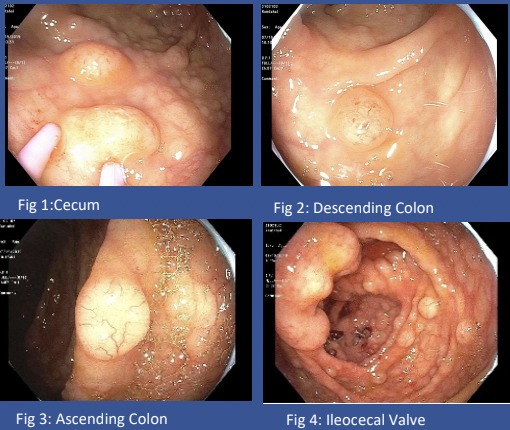Back


Poster Session D - Tuesday Morning
Category: Colon
D0153 - Mantle Cell Lymphoma Presenting as Multiple Lymphomatous Polyposis of the Colon
Tuesday, October 25, 2022
10:00 AM – 12:00 PM ET
Location: Crown Ballroom

Has Audio

Syed Salman Hamid Hashmi, MD
NYU Langone Medical Center/ Woodhull Medical Center
New York, New York
Presenting Author(s)
Nazia Sadiq, MD, Syed Salman Hamid Hashmi, MD, Patrik Mlodzianowska, MD, Gulam Mustafa Khan, MD
NYU Langone Medical Center/ Woodhull Medical Center, New York, NY
Introduction: Mantle Cell Lymphoma (MCL), a type of non-Hodgkin lymphoma (NHL) is an aggressive neoplasm affecting the lymphatic system. Its incidence is 1–2 cases/105 people/year and accounts for only 5-6% of all cases of NHL. Multiple lymphomatous polyposis (MLP) is a rare presentation seen in MCL consisting of diffuse nodules or polyps covering multiple sites of the gastrointestinal tract.
Case Description/Methods: A 68-year-old female with a past medical history of hypertension presented to the clinic with a one-year history of mild diffuse abdominal pain, change in bowel habits including loose stools, and significant involuntary weight loss. A review of systems, physical examination, and routine blood work was non-remarkable. The upper endoscopy was normal but a colonoscopy revealed numerous 1-10 mm submucosal nodules in the entire colon. Biopsies obtained from the nodules of the colon revealed colonic mucosa infiltrated with monotonous, small to medium-sized lymphocytes with irregular nuclear contour, and scant cytoplasm. Immunohistochemistry and immunophenotypic analysis were positive for CD20, CD5, Cyclin D1, BCL6, BCL 2, SOX 11, and negative for CD 10, and P 53. FISH testing revealed 11,14 translocations, consistent with Mantle Cell Lymphoma. CT scan of the abdomen showed pre-carinal, right hilar, extensive para-aortic, and mesenteric lymphadenopathy consistent with stage 4 Mantle Cell Lymphoma. She was subsequently started on Bendamustine and Rituximab combination therapy followed by Rituximab for maintenance. There was a significant improvement in her clinical status with progressive weight recovery. Follow-up upper and lower endoscopic examinations after six cycles revealed complete remission with the absence of all polypoid lesions in the GI tract.
Discussion: The initial presentation of MCL can widely vary from being asymptomatic to having systemic symptoms of fever and weight loss to marked lymphadenopathy on physical examination. Although 15-30% of individuals with Mantle cell lymphoma (MCL) are reported with involvement in the gastrointestinal (GI) tract, MLP is seen only in less than 10%. It is important for clinicians to not only incorporate MCL as a differential in their workup when they come across diffuse polyps in the GI tract but also to differentiate it from other similar disease processes that present with multiple polyps in the colon. A definitive diagnosis of MLP requires biopsy and histological examination of the tissue with immunophenotypic and immunohistochemistry analysis.

Disclosures:
Nazia Sadiq, MD, Syed Salman Hamid Hashmi, MD, Patrik Mlodzianowska, MD, Gulam Mustafa Khan, MD. D0153 - Mantle Cell Lymphoma Presenting as Multiple Lymphomatous Polyposis of the Colon, ACG 2022 Annual Scientific Meeting Abstracts. Charlotte, NC: American College of Gastroenterology.
NYU Langone Medical Center/ Woodhull Medical Center, New York, NY
Introduction: Mantle Cell Lymphoma (MCL), a type of non-Hodgkin lymphoma (NHL) is an aggressive neoplasm affecting the lymphatic system. Its incidence is 1–2 cases/105 people/year and accounts for only 5-6% of all cases of NHL. Multiple lymphomatous polyposis (MLP) is a rare presentation seen in MCL consisting of diffuse nodules or polyps covering multiple sites of the gastrointestinal tract.
Case Description/Methods: A 68-year-old female with a past medical history of hypertension presented to the clinic with a one-year history of mild diffuse abdominal pain, change in bowel habits including loose stools, and significant involuntary weight loss. A review of systems, physical examination, and routine blood work was non-remarkable. The upper endoscopy was normal but a colonoscopy revealed numerous 1-10 mm submucosal nodules in the entire colon. Biopsies obtained from the nodules of the colon revealed colonic mucosa infiltrated with monotonous, small to medium-sized lymphocytes with irregular nuclear contour, and scant cytoplasm. Immunohistochemistry and immunophenotypic analysis were positive for CD20, CD5, Cyclin D1, BCL6, BCL 2, SOX 11, and negative for CD 10, and P 53. FISH testing revealed 11,14 translocations, consistent with Mantle Cell Lymphoma. CT scan of the abdomen showed pre-carinal, right hilar, extensive para-aortic, and mesenteric lymphadenopathy consistent with stage 4 Mantle Cell Lymphoma. She was subsequently started on Bendamustine and Rituximab combination therapy followed by Rituximab for maintenance. There was a significant improvement in her clinical status with progressive weight recovery. Follow-up upper and lower endoscopic examinations after six cycles revealed complete remission with the absence of all polypoid lesions in the GI tract.
Discussion: The initial presentation of MCL can widely vary from being asymptomatic to having systemic symptoms of fever and weight loss to marked lymphadenopathy on physical examination. Although 15-30% of individuals with Mantle cell lymphoma (MCL) are reported with involvement in the gastrointestinal (GI) tract, MLP is seen only in less than 10%. It is important for clinicians to not only incorporate MCL as a differential in their workup when they come across diffuse polyps in the GI tract but also to differentiate it from other similar disease processes that present with multiple polyps in the colon. A definitive diagnosis of MLP requires biopsy and histological examination of the tissue with immunophenotypic and immunohistochemistry analysis.

Figure: Figure 1,2,3,4 show multiple sessile polypoid lesions of different sizes throughout the colon
Disclosures:
Nazia Sadiq indicated no relevant financial relationships.
Syed Salman Hamid Hashmi indicated no relevant financial relationships.
Patrik Mlodzianowska indicated no relevant financial relationships.
Gulam Mustafa Khan indicated no relevant financial relationships.
Nazia Sadiq, MD, Syed Salman Hamid Hashmi, MD, Patrik Mlodzianowska, MD, Gulam Mustafa Khan, MD. D0153 - Mantle Cell Lymphoma Presenting as Multiple Lymphomatous Polyposis of the Colon, ACG 2022 Annual Scientific Meeting Abstracts. Charlotte, NC: American College of Gastroenterology.
